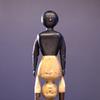PEM exclusive East Coast venue for major Calder exhibition
- SALEM, Massachusetts
- /
- June 18, 2014
The Peabody Essex Museum (PEM) is pleased to be the exclusive East Coast venue for Calder and Abstraction: From Avant-Garde to Iconic. Organized by the Los Angeles County Museum of Art (LACMA) and in collaboration with the Calder Foundation, this exhibition brings together 40 sculptures by one of the most influential and innovative artists of the 20th century. Featuring mobiles, stabiles and maquettes made between the 1930s and the late 1960s, this exhibition celebrates Alexander Calder’s pivotal contributions to modern art and his revolutionary approach to sculpture. Calder and Abstraction is on view at PEM from September 6, 2014, to January 4, 2015.
“Liberated from pedestals -- and even from the ground itself -- Calder’s work casts aside traditional sculptural techniques in favor of an entirely original visual vocabulary and conceptual framework,” said Lynda Roscoe Hartigan, PEM’s James B. and Mary Lou Hawkes Chief Curator. “Calder revealed sculpture’s potential to be ethereal, kinetic and poetic while simultaneously extending its capacity to explore abstraction and metaphor through color, form, line and volume.”
Born in Pennsylvania to a family of accomplished sculptors, Calder traveled to Paris frequently in the 1920s and ‘30s where he befriended members of the artistic avant-garde, including Marcel Duchamp, Joan Miró, Jean Arp and Wassily Kandinsky. It was in this epicenter of creative production and at the heart of the Surrealist and Abstract-Constructivist movements where Calder bloomed creatively. As he later recalled, a revelatory moment came during Calder’s visit to Piet Mondrian’s studio in 1930 where he experienced a shock, “though I had heard the word ‘modern’ before, I did not consciously know or feel the term ‘abstract.’ So now, at 32, I wanted to paint and work in the abstract.”
In the decade that followed, Calder produced his most career-defining and radical work. In a challenge to the tradition of monumental, figurative sculpture, Calder combined elements of the playful and the technical to create open compositions of motion. Linear elements and open shapes replaced solid volumes while flat planes replaced 3-D volumes. Through the innovative use of wire and sheet metal, Calder explored two key sculptural forms that were termed mobiles – hanging kinetic sculptures made of discrete movable parts – and stabiles – stationary abstract sculptures.
From small-scale works like Little Pierced Disc (c. 1947) to monumental works like La Grande Vitesse (1969), recurring themes such as linearity, dimensionality, biomorphic forms and the tension between mass and weightlessness emerge. Another enduring fascination of Calder’s was the dynamic movement of the cosmos. As Calder explained, “[T]he underlying sense of form in my work has been the system of the Universe, or part thereof … What I mean is the idea of detached bodies floating in space of different sizes and densities, perhaps of different colors and temperatures … some at rest while others move in peculiar manners, seems to me the ideal source of form.”
In the mid-1950s, Calder began working with ¼ -inch steel in order to construct larger, more durable and ambitious stabiles that were ideal for public spaces. After winning a series of international commissions for museum plazas, corporate headquarters and government offices, Calder simultaneously redefined post-war public sculpture and secured his reputation as one of the most popular American artists worldwide. From his studios in Roxbury, Connecticut, and Saché, France, Calder produced site-specific stabiles nonstop until his death in 1976.
Calder’s curvilinear creations can alternately be stirred into motion by air currents or stand muscular but gracefully in public plazas. Their synthesis of science and poetry, pattern and balance, chance and humor led Albert Einstein, after encountering Calder’s work in 1943 to remark, “I wish I had thought of that.”
LACMA’s senior curator of modern art Stephanie Barron organized the exhibition. PEM’s Chief Curator Lynda Roscoe Hartigan coordinated PEM’s presentation.
A 256-page catalog accompanies the exhibition and includes 200 images, an annotated bibliography and illustrated exhibition chronology. Calder and Abstraction: From Avant-Garde to Iconic is co-edited by Stephanie Barron and Lisa Gabrielle Mark and features essays by Stephanie Barron, Jed Perl, Aleca Le Blanc, Ilene Susan Fort and Harriet F. Senie. Available in the PEM Shop and online at pemshop.com.












100x100_c.jpg)



